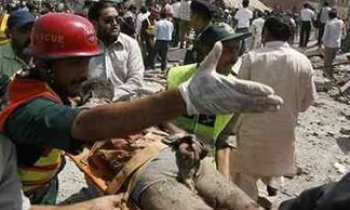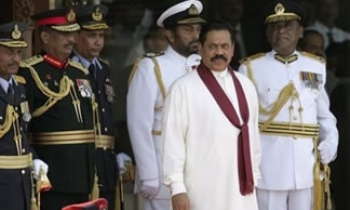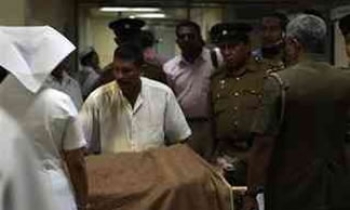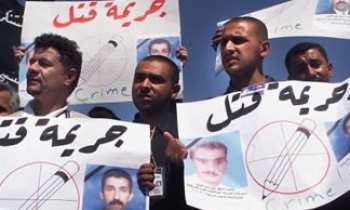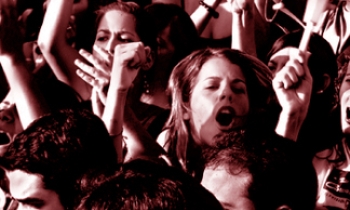The media is becoming a hostage in the southern Mexican state of Oaxaca, where teachers are leading a statewide strike that has dragged on for over three months, and the police have opened fire on demonstrators and journalists a number of times.

On August 22, newspaper photographers Jorge Luis Plata of Reforma and Luis Alberto Cruz of Milenio and a TV crew with Televisión Azteca came under fire while covering a police operation aimed at evicting Popular Assembly of the People of Oaxaca (APPO) activists who had been occupying radio La Ley for the past 24 hours.
Plata said they were taking photographs of the police vehicles carrying out the eviction when the police began firing at them. They hid behind posts to avoid being shot. Edgar Galicia of Televisión Azteca said the police confiscated their cameras and microphones as well as all the mobile phones of APPO members.
The teachers of the state of Oaxaca have been protesting for three months for a salary increase, backed by APPO. They are also demanding the resignation of the state governor, Ulises Ruiz. Most public schools have been closed. Provoked by the intervention of security forces, the strikers blocked the entry ways to the city with barricades of busses and burning tyres.
The historic city centre, designated a world cultural heritage site by Unesco, has been blockaded by a tent city since end-May. The state's 70,000 teachers went on strike as negotiations over a salary increase collapsed. On Thursday, the US State Department told Americans that rising political violence might make Oaxaca too risky to visit.
Protesters including striking school teachers seized 12 private radio stations on August 21 after unidentified assailants shot up a government-owned station already under the demonstrators’ control. At least 50 APPO protesters, simultaneously took over each of the stations in the city of Oaxaca, 520 km southeast of Mexico City. The protesters were armed with pipes, wooden planks, and clubs.

Local journalists Soledad Jarkin and Pedro MatÃas told the Committee to Protect Journalists that the stations were Radio Oro, Magia 680, Tú FM, La Grande 89.7, Estéreo Cristal, La ley 710, Estéreo Exitos AM/FM, Radio Mexicana, Súper Q 101.1 FM, Dimensión 820 AM, La Grande de Oaxaca, and La Tremenda de Oaxaca. Station owners told a news conference that 25 employees of Radio Oro, La Ley 710 and Radio Mexicana were being held by strikers, according to MatÃas of Noticias, Voz e Imagen de Oaxaca.
“We call on all sides of this dispute to stop targetting the media,†said Joel Simon, CPJ executive director. “The employees of the radio stations being held by strikers should be released immediately, and the stations should be allowed to resume broadcasting.â€
An APPO activist told CPJ that the strikers decided to take over the radio stations in response to an attack at 3:30 a.m. that morning on Corporación Oaxaqueña de Radio y Televisión (CORTV), a state-owned television and radio station seized by protesters August 1. APPO blamed the Oaxaca government for the assault.
Ruiz denied any involvement in the attack. In a statement, he condemned the seizure of the private radio stations, calling it a “federal crime.†A spokesman for President Vicente Fox said that the federal government was monitoring the situation but had no plans to send in federal police to restore order.
The shooting caused damage to the studios and injured unionist Sergio Vale Jiménez, who was rushed to hospital. It also cut short the broadcasts which APPO was carrying out with the help of employees held inside the station. At the time of the attack, APPO was broadcasting the demands of the National Union of Education Workers (STNE), which is calling on the governor to step down.

“We are dismayed by the repeated attacks that have been seriously affecting press freedom for the past two months in Oaxaca,†Reporters sans Frontières (RSF) said. “It is urgent that peace should be restored and that the armed attacks and occupations of public and privately-owned media should stop. The coexistence of free, critical and independent media is essential in any democracy.â€
It added: “In view of the impossibility of this problem being resolved by the local government, we call on the federal authorities to intervene and to put an end to the intimidation, threats and violence against media and journalists as soon as possible.â€
The August 21 incident was just the latest in a series of attacks on the press.
On August 9, two masked assailants broke into the distribution and delivery area of the Oaxaca-based daily Noticias, Voz e Imagen de Oaxaca and opened fire, injuring five employees. The attackers entered the newspaper premises looking for the owner Ericel Gómez Nucamendi, said editor Ismael SanmartÃn Hernández. They fired a round of bullets causing minor injuries to five distribution employees. The assailants also took a laptop computer and at least 5,000 Mexican pesos (US$460).
Gómez accused Oaxaca’s governor Ulises Ruiz Ortiz of instigating the attack in response to the paper’s harsh criticism. Miguel Angel Concha Viloria, a spokesman for the governor, rejected the accusation as false. The Oaxaca state prosecutor and the special prosecutor for crimes against the press have opened investigations into the attack.
Noticias, the largest circulation daily in Oaxaca, has been operating out of temporary offices since June 2005, when members of the Revolutionary Confederation of Workers and Peasants (CROC), a trade union linked to the ruling party Partido Revolucionario Institucional (PRI), occupied its permanent offices. SanmartÃn told CPJ that managers and journalists have been unable to go back because all entrances to the offices are still blocked by the state police.

Oscar RodrÃguez, the Oaxaca correspondent for the Mexico City-based daily Milenio, was attacked by a group of protesters August 8 while reporting on the abduction of two police officers in the city of San Bartolo de Coyotepec. Members of APPO took two police officers hostage after they attempted to arrest a community leader, the local press said.
When RodrÃguez approached the building where the policemen were being held, a group of activists told him that they didn’t want any press, and that he should leave, the reporter said. RodrÃguez was trying to leave when he was hit on the head with a heavy object. The journalist said that a schoolteacher intervened and drove him to a nearby pharmacy where he received first aid.

